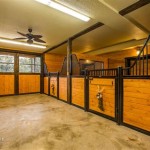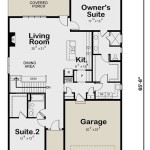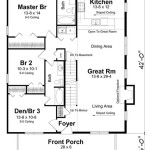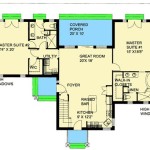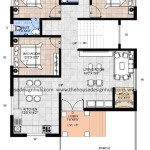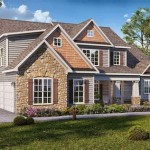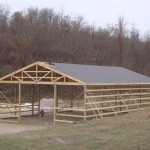Exploring the Appeal of 1 1/2 Story House Plans
The 1 ½ story house plan, sometimes referred to as a Cape Cod or story-and-a-half style, represents a compelling compromise between the compactness of a single-story ranch and the expansive feel of a full two-story home. This design offers unique benefits in terms of aesthetics, functionality, and affordability, making it a popular choice for a wide range of homebuyers. The defining characteristic of a 1 ½ story house is its upper level, which features sloping rooflines that extend down to meet the exterior walls, creating dormer windows that provide light and ventilation to the upper living spaces.
This architectural style boasts a rich history, originating in the colonial era and evolving over time to incorporate modern amenities and design sensibilities. The low profile and efficient use of space have contributed to its enduring appeal. While traditionally associated with smaller homes, modern 1 ½ story plans can range in size, offering ample living space for families of various sizes.
This house plan is not without its specific considerations. The sloped ceilings on the upper level require careful planning to maximize usable space and ensure comfortable headroom. However, when executed effectively, these design features can add character and charm to the home, creating cozy and inviting living areas.
Key Advantages of 1 ½ Story House Plans
One of the primary advantages of a 1 ½ story house plan is its affordability. Generally, this style of home is less expensive to build than a full two-story house. This is primarily due to the reduced amount of framing and materials required for the upper level. The sloping roofline minimizes the need for full-height walls, which translates into lower construction costs. This cost-effectiveness makes 1 ½ story plans an attractive option for first-time homebuyers, those looking to downsize, or individuals with a budget in mind.
Furthermore, the design can contribute to lower heating and cooling costs. The lower roofline and reduced wall space can result in better energy efficiency. The upper level tucked under the roof is naturally insulated, reducing the need for excessive heating in winter and cooling in summer. While proper insulation is crucial regardless of design, the inherent characteristics of the 1 ½ story house can contribute to significant energy savings over the lifespan of the home.
Another benefit is the aesthetic appeal of the style. The charming dormer windows, the sloping roofline, and the overall cottage-like feel evoke a sense of warmth and character. This style lends itself well to various architectural details, such as front porches, decorative shutters, and cozy fireplaces, which can enhance its curb appeal and create a welcoming atmosphere.
Maximizing Space and Functionality in 1 ½ Story Homes
Effective space planning is paramount in a 1 ½ story house to overcome the potential challenges posed by the sloping ceilings. Careful consideration must be given to the placement of furniture, the design of storage solutions, and the overall layout of the upper level. Utilizing knee walls, which are short walls that extend from the floor to the sloping ceiling, can create valuable storage space and delineate different areas within the room.
Dormer windows play a crucial role in maximizing natural light and ventilation on the upper level. Strategically positioning dormers can significantly improve the livability of the space and prevent it from feeling cramped or claustrophobic. Dormers also provide valuable headroom and visual interest, enhancing the overall aesthetic appeal of the home.
Consideration should also be given to the accessibility of the upper level. A well-designed staircase is essential for comfortable and safe access. In some cases, it may be beneficial to incorporate a wider staircase or a landing to accommodate individuals with mobility issues. Alternatively, for a larger budget, an elevator could be installed.
The main floor layout is equally important. Open-concept designs can create a sense of spaciousness and flow, while well-defined rooms can provide privacy and functionality. Integrating the main floor with the upper level through open staircases and strategically placed windows can create a cohesive and harmonious living environment.
Vertical space utilization is critical. Built-in shelving, high ceilings in the main living areas, and lofted spaces can all contribute to a feeling of expansiveness. Creative storage solutions, such as under-stair storage, can help to maximize every square foot of the home. The design should emphasize functionality and efficiency while maintaining aesthetic appeal.
Design Considerations and Customization Options
The 1 ½ story house plan offers ample opportunities for customization. The exterior style can range from traditional Cape Cod to modern farmhouse, depending on the preferences of the homeowner. The roofline, siding materials, and window styles can all be tailored to create a unique and personalized look.
Interior finishes can be customized to reflect the homeowner's individual taste and lifestyle. Hardwood floors, custom cabinetry, and decorative lighting can enhance the aesthetic appeal and create a comfortable and inviting living environment. The layout can be modified to accommodate specific needs, such as a home office, a playroom, or a guest suite.
Consideration should be given to the orientation of the house on the lot. Optimizing the positioning of the house to maximize sunlight exposure can reduce heating costs and improve the overall livability of the space. The placement of windows and doors should be carefully considered to take advantage of natural light and views.
The landscaping surrounding the house can also enhance its curb appeal and create a welcoming atmosphere. A well-designed garden, a landscaped yard, and a welcoming front porch can all contribute to the overall charm of the home. Sustainable landscaping practices can also reduce water consumption and promote environmental stewardship.
While the architectural style boasts a rich history, modern interpretations of the 1 ½ story house plan often incorporate energy-efficient features, such as solar panels, rainwater harvesting systems, and smart home technology. These features can reduce the environmental impact of the home and lower utility costs. Integrating sustainable design principles into the construction process can also contribute to a healthier and more comfortable living environment.

1 2 Story Traditional House Plan Heinman

1 2 Story Modern Farmhouse House Plan Rochester

Pin Page

Two Story House Plans Series Php 2024012 Pinoy

House Plan 66719ll Quality Plans From Ahmann Design

Single Family 2 Story Houses Home Plans Unique House Floor Pl

Farmhouse House Plan 3 Bedrms 2 5 Baths 1675 Sq Ft 178 1251

Small House Floor Plans Schmidt Homes Inc

Contemporary Floor Plan 3 Bedrms 5 Baths 3404 Sq Ft 146 2953

Affordable Two Story 1 Bedroom House Plans Drummondhouseplans

